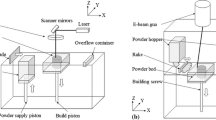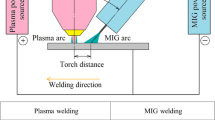Abstract
In conventional MIG/MAG welding process, the root of some of the most frequent problems is related to current variation due to solid wire electrode extension (stick out) alteration. This becomes most relevant in semi-automatic welding procedures, where the welding operator is responsible for holding the torch. Inevitably, the contact tip-to-workpiece distance, and as a result, the stick out length, will oscillate due to operational difficulties, such as complex geometry and out-of-position welding. Since the average current has decisive influence over various weld properties, variations in its values incur in reduction of process and weld regularity, repeatability, robustness and reliability. The present work investigates and quantifies the effects such as current drop and electrode temperature profile based on well-known theoretical–analytical concepts under an application oriented standpoint, so as to scientifically support research and development of modern MIG/MAG welding adaptive systems. Results pointed a higher wire preheating degree in spite of lower current levels when stick out is increased. Experiments showed a weld bead geometrical reduction, which can be avoided through an intelligent system, capable of identifying welding current behavior, electrode voltage fall and electrical resistance curves for process online correction and prevention of possible defects.







Similar content being viewed by others
References
Silva RHG (2005) Soldagem MIG/MAG em transferência metálica por curto-circuito controlado aplicada ao passe de raiz. Programa de Pós-Graduação em Engenharia Mecânica, Universidade Federal de Santa Catarina, Florianópolis
Roβmann F (2015) Advanced pulse welding characteristics. Weld Cut 14:12–14
Cruz JG, Torres EM, Alfaro SC (2015) A methodology for modeling and control of weld bead width in the GMAW process. J Braz Soc Mech Sci Eng 37:1529–1541
Nele L, Sarno E, Keshari A (2013) Modeling of multiple characteristics of an arc weld joint. Int J Adv Manuf Technol 69:1331–1341
Saraev Y (2014) The development and application of adaptive pulse-ar welding methods for construction and repair of pipelines (MEACS) Tomsk 16–18 October
Mvola B, Kah P, Martikainen J, Hiltunen E (2013) Applications and benefits of adaptive pulsed GMAW. Mechanika 19:694–701
Yan Z, Zhang G, Wun L (2011) Simulation and controlling for weld shape process in P-GMAW based on fuzzy logic. In: Proceedings of the 2011 IEEE international conference on mechatronics and automation august 7–10, Beijing
Silva RHG, Dutra JC, JrR Gohr (2008) Fundamentos científicos e tecnológicos para o desenvolvimento do processo MIG/MAG por curto-circuito controlado (CCC)—uma revisão da literatura. Parte 3 de 3: princípios dos sistemas MIG/MAG em curto-circuito com controle de corrente. Soldagem e Inspeção 13:70–81
Mendonça FK (2013) Evolução da técnica de seguimento de junta via sensoriamento do arco para operações de soldagem em posições forçadas. Programa de Pós-Graduação em Engenharia Mecânica, Universidade Federal de Santa Catarina, Florianópolis
Lesnewich A (1958) Control of melting rate and metal transfer in gas-shielded metal-arc welding part I—control of electrode melting rate. Welding Research Supplement 343–353
French IE (1984) Effects of electrode extension on deposit charactreristics and metal transfer of E70T-4 electrodes. Weld J 63(3):167–172
Waszink JH, Van Den Heuvel GJPM (1982) Generation and heat flow in the filler metal in GMA welding. Weld J 61:269–280
Waszink JH, Van Den Heuvel GJPM (1979) Measurements and calculations of the resistance of the wire extension in arc welding. arc physics and weld pool behaviour international conference. May 8–10, London
Scotti A, Ponomarev V (2014) Soldagem MIG/MAG: melhor entendimento, melhor desempenho. Artiliber Editora Ltda, São Paulo
Essers WG, Walter R (1979) Some aspects of the penetration mechanisms in metal inert gas (MIG) welding. arc physics and weld pool behaviour international conference 8–10 London
Kim JW, Na SJ (1995) A study on the effect of contact tube-to-workpiece distance on weld pool shape in gas metal arc welding. Weld J 74(5):141–152
Traidia A, Roger F, Guyot E (2010) Optimal parameters for pulsed gas tungsten arc welding in partially and fully penetrated weld pools. Int J Therm Sci 49:1197–1208
Santana IJ, Modenesi PJ (2011) Modelagem matemática do processo de soldagem gmaw—transferência por vôo livre. Soldagem e Inspeção 16:213–222
ASM (1990) ASM Metals Handbook, Physical properties of carbon and low alloy steels. ASM, Russell Township
Labsolda (2010) Vídeo Stick Out. https://www.youtube.com/watch?v=uFWONovK1-Q. Accessed 19 January 2017
Author information
Authors and Affiliations
Corresponding author
Additional information
Technical Editor: Márcio Bacci da Silva.
Rights and permissions
About this article
Cite this article
e Silva, R.H.G., dos Santos Paes, L.E., Barbosa, R.C. et al. Assessing the effects of solid wire electrode extension (stick out) increase in MIG/MAG welding. J Braz. Soc. Mech. Sci. Eng. 40, 31 (2018). https://doi.org/10.1007/s40430-017-0948-9
Received:
Accepted:
Published:
DOI: https://doi.org/10.1007/s40430-017-0948-9




